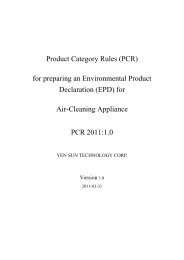Product Category Rules (PCR) - PCR Library
Product Category Rules (PCR) - PCR Library
Product Category Rules (PCR) - PCR Library
You also want an ePaper? Increase the reach of your titles
YUMPU automatically turns print PDFs into web optimized ePapers that Google loves.
5<br />
Range of assessment<br />
5-1 Calculation unit Sales unit.<br />
“downgrade recycling”.<br />
(19) Closed recycling (refer to “EcoLeaf Method of Calculating <strong>Product</strong><br />
Environmental Load during Recycling/Reuse”; Japan Environmental<br />
Management Association for Industry: 2004)<br />
- Reuse of waste products as recycled materials for products of the same type<br />
as the original ones.<br />
(20) Material recycling [Mechanical recycling] (refer to JIS Z 0112: 2008)<br />
- Recycling of waste as materials or raw materials. It is also called “resource<br />
recycling” or simply “recycling”.<br />
- More specifically, used products, waste from production process, and the like<br />
are collected, processed into forms suitable for recycling, and reused as<br />
materials or raw materials for new products. (Processing associated with<br />
chemical change is not performed. Waste is pulverized into flakes or pellets,<br />
and recycled as raw materials. Recycling methods requiring a high cleaning<br />
level and solid polycondensation process are also included.)<br />
(21) Chemical recycling [Feedstock recycling] (refer to JIS Z 0112: 2008)<br />
- A technique of recycling used resources after changing their composition<br />
through chemical reaction.<br />
- It usually refers to recycling of waste plastics with oil production, gasification<br />
and coke-oven chemical raw material method. (In the case of recycling of<br />
used PET bottles, they are chemically decomposed into the substances that<br />
serve as the raw materials of PET resin, and they are reused to produce PET<br />
resin again.)<br />
(22) Thermal recycling<br />
- A process in which waste plastics are burned, and the thermal energy<br />
released is utilized to supply heat or electricity usually in the form of hot water,<br />
steam and electric power. It is also called “energy recovery”.<br />
5-2 Life cycle stages The life cycle stages (see page15 supplementary remark for better<br />
understanding) :<br />
- In the case of intermediate goods (B-to-B products), (1) the raw material<br />
acquisition stage and (5) the disposal and recycling stage shall be covered.<br />
However, (1) the raw material acquisition stage shall be divided into three<br />
stages:<br />
“(1-(1)) Container/packaging raw material acquisition stage”<br />
“(1-(2)) Container/packaging production stage”<br />
“(1-(3)) Container/packaging transport stage”<br />
- When this <strong>PCR</strong> is used for “final consumer goods” supplied to consumers,<br />
five life cycle stages shall be covered. The three stages mentioned above<br />
shall correspond to the following stages, respectively.<br />
“(1-(1)) Container/packaging raw material acquisition stage” => “(1) Raw<br />
material acquisition stage”<br />
“(1-(2)) Container/packaging production stage” => “(2) <strong>Product</strong>ion stage”<br />
“(1-(3)) Container/packaging transport stage” => “(3) Distribution stage”<br />
Basically, this <strong>PCR</strong> is developed for intermediate plastic containers and<br />
packaging, the classification of the life cycle stages is unique.<br />
6 General requirements applied to all stages<br />
6-1 Life cycle flow chart - Life cycle flow chart is provided in Annex A (normative). The charts of<br />
containers/packaging for business use and consumer use are provided in<br />
“Annex A.1” and “Annex A.2”, respectively. These charts are conceptual charts<br />
intended to make it easy to identify the “processes covered by each life cycle<br />
stage”.<br />
- When calculating GHG emissions, a detailed life cycle flow chart for each type<br />
-5-















